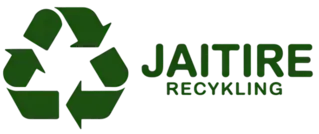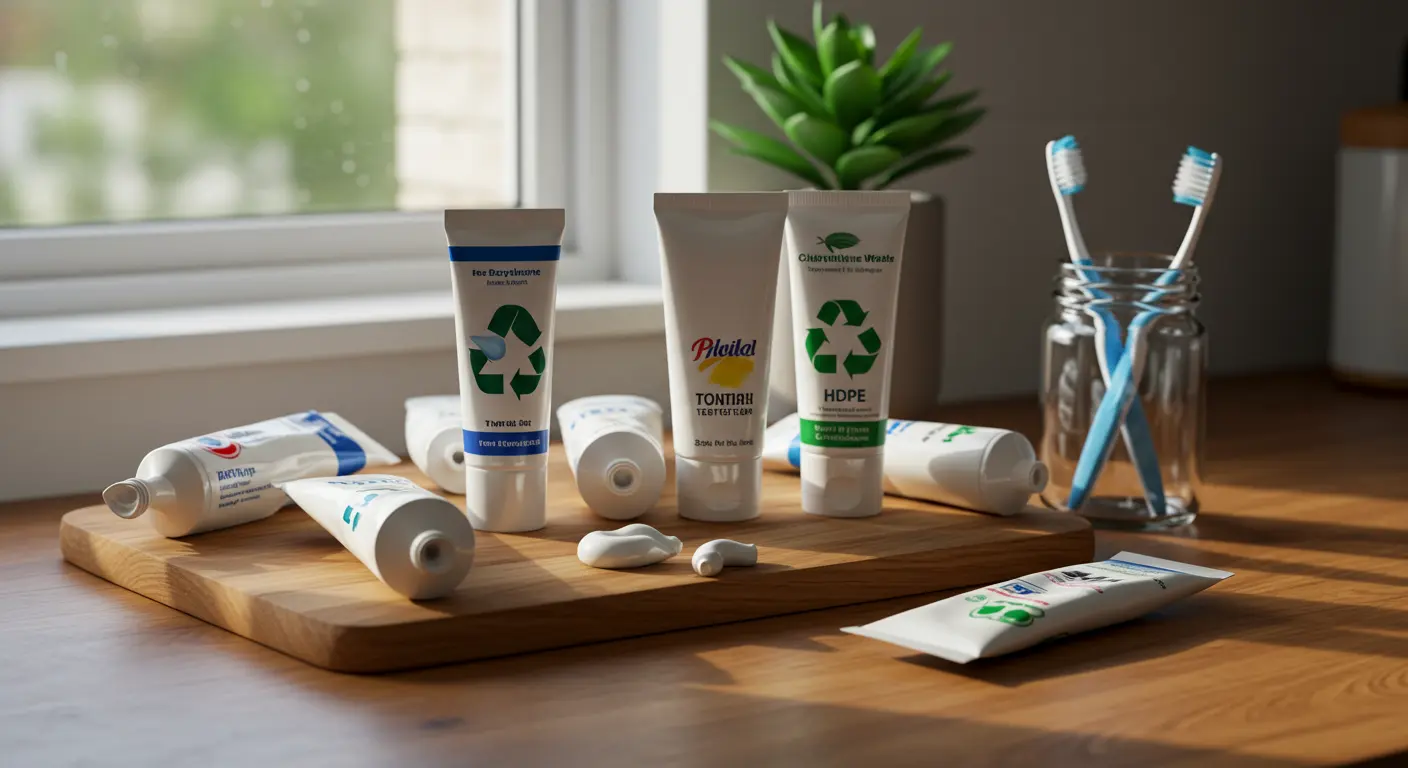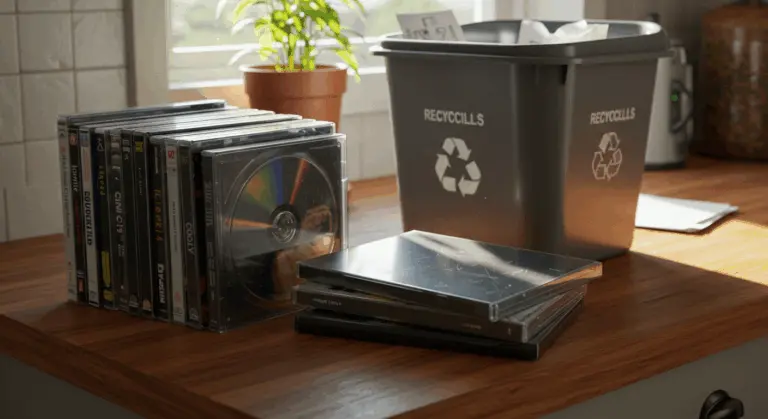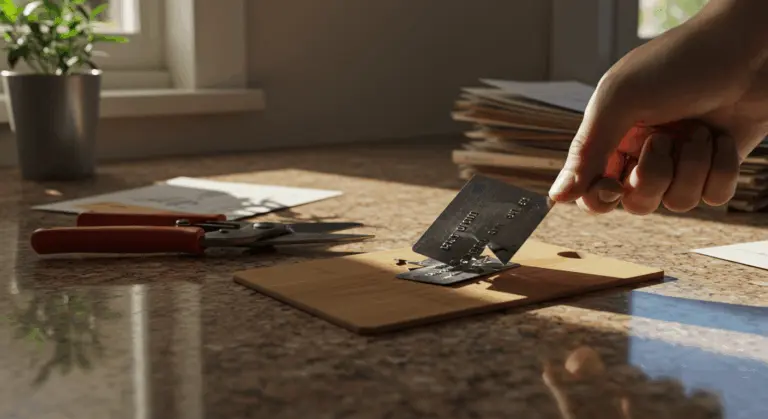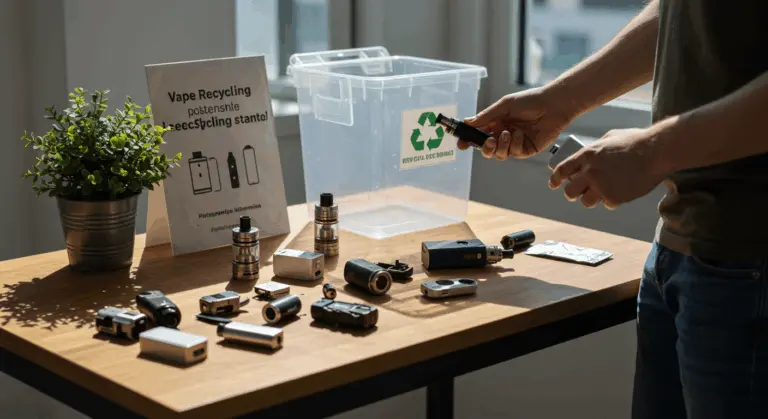Understanding Toothpaste Tubes – Materials and Structure
Traditional toothpaste tubes represent remarkable feats of engineering, carefully designed to preserve dental care products. However, this complexity makes recycling difficult.
Most conventional tubes use complex multi-layered construction, combining flexible plastics like polyethylene (PE) with protective aluminum barriers. The plastic delivers essential flexibility. The aluminum foil acts as a barrier against moisture and oxygen infiltration. Caps typically employ yet another plastic variant, further complicating the material composition.
This fused, multi-material construction explains why recycling facilities struggle to process them. Standard equipment cannot separate the bonded layers, contaminating recycling streams and diminishing output value. Consequently, most toothpaste tubes have historically found their way to landfills.
Recycling Symbols – What They Mean for Toothpaste Tubes
Understanding recycling symbols is important for proper disposal—they serve as your roadmap for determining whether and how a tube can be recycled.
When examining your toothpaste tube, search for specific recycling indicators. Manufacturers may employ proprietary recycling symbols or utilize widely recognized codes like the resin identification for High-Density Polyethylene (HDPE)—appearing as a triangle containing the number 2.
You may encounter several other symbols:
-
Möbius Loop: The three chasing arrows indicate general recallability but do not guarantee local acceptance.
-
Green Dot: This symbol signifies that the manufacturer has contributed financially to recycling programs, not that the packaging itself is recyclable.
Recycling symbols, however, can breed confusion. In the UK, toothpaste tubes became known of being the second most frequently “wish-cycled” item. These are products consumers optimistically toss into recycling bins, hoping they’ll be processed. This practice contaminates recycling streams and undermines recycling efforts.
Remember: a recycling symbol’s presence doesn’t guarantee local facility acceptance. Always verify with your municipal program before depositing tubes in recycling bins.
Are Toothpaste Tubes Recyclable? The Current Landscape
Toothpaste tube recallability has changed significantly in recent years, but the situation remains complex. Traditionally, these everyday items have been notoriously difficult to recycle due to their complex, mixed-material composition. Their complex design makes them incompatible with conventional recycling infrastructure. The result? Billions of tubes accumulating in landfills across the globe.
The amount of waste is enormous. In the United States alone, more than 400 million empty toothpaste tubes are discarded annually. These resilient containers require over five centuries to decompose in landfills—creating an enormous environmental burden. Designed for durability and product preservation, conventional toothpaste tubes have historically been rejected by most local municipal recycling programs.
However, things are changing. Through collaborations between oral healthcare brands and organizations like WRAP (Waste and Resources Action Program) in the UK, toothpaste tubes are entering a new era of sustainability. Tubes once condemned to landfills can now find new life through curbside collections in select regions. This represents an important change in waste management practices.
The industry is also making progress. Major toothpaste brands representing approximately 90% of the US market have pledged to transition to recyclable HDPE (High-Density Polyethylene) tubes by 2025. HDPE offers significantly improved recallability compared to conventional multi-layer alternatives.
Environmentally conscious consumers now have options beyond municipal recycling. Some out-of-home recycling points specifically accept toothpaste tubes, providing an alternative disposal method for those who care about the environment. These specialized hubs bridge the current gap as industry transitions toward universally recyclable packaging.
The toothpaste tube recycling situation shows significant progress. However, not all areas accept them yet.
Challenges in Recycling Toothpaste Tubes
Local recycling systems often can’t keep up with new packaging designs, creating problems. Municipal authorities often reject even technically recyclable tubes, concerned about contaminating other materials.
Consumer confusion compounds these challenges. Inconsistent regional recycling rules and ambiguous guidance fuel widespread ‘wish-cycling.’ This well-intentioned but misguided practice can doom entire batches of recyclables to landfills.
Recycling Options – How to Recycle Toothpaste Tubes
As recyclable toothpaste tubes become more common, consumers have several practical ways to keep these items out of landfills. The most convenient option for many households is curbside recycling.
When local recycling isn’t available, retail drop-off locations offer excellent alternatives. Major retailers like Boots and Super drug have implemented in-store recycling schemes specifically designed for bathroom plastics, including toothpaste tubes. Boots operates the ‘Recycle at Boots’ program, while Super drug has partnered with Maybelline and Terra Cycle to offer similar collection points. These strategically placed collection points transform routine shopping trips into opportunities for responsible disposal.
Terra Cycle provides comprehensive mail-back solutions. Consumers can download a free shipping label from their website and send items like toothpaste tubes, caps, toothbrushes, and floss containers for specialized recycling. This proves especially valuable for older, multi-material tubes rejected by standard recycling streams. Some oral care brands have also established their own recycling initiatives, partnering with Terra Cycle to provide brand-specific collection programs.
Always examine packaging for specific recycling instructions before disposal. Newer recyclable tubes often include guidance on proper disposal methods, and manufacturer websites frequently provide detailed information about the recallability of their products.
Participating in Community Recycling Programs
Community recycling programs use group efforts to address toothpaste tube disposal challenges effectively. Schools, workplaces, and community centers can establish dedicated collection points specifically for oral care products, making recycling more accessible for everyone. These organizations frequently forge partnerships with local recycling facilities or specialized processors. This creates sustainable waste management solutions that go beyond what individual households can do.
More manufacturers are taking responsibility for their packaging, launching take-back programs for their packaging. Participating in these initiatives not only helps divert waste from landfills but can also provide tangible benefits. Programs like Terra Cycle’s brand partnerships reward participants with points for recycling efforts. These points can be used for charitable donations or product rewards. This system encourages consistent participation while supporting environmental and social causes.
Innovative pilot programs are emerging to serve communities lacking established recycling infrastructure. The Hefty Renewal™ program, available in select municipalities, accepts hard-to-recycle plastics including toothpaste tubes through special collection bags. Other options include subscription-based recycling services through specialty recyclers who provide mail-back envelopes or containers specifically designed for bathroom products. Some communities have also installed collection bins in public spaces like parking lots or community centers, making responsible disposal more convenient for residents. These local programs show how community-led solutions can make a real difference when municipal recycling systems fall short.
Alternatives to Traditional Toothpaste Tubes
Increased environmental awareness has led to innovation in toothpaste packaging alternatives. Many sustainable options are now available for environmentally minded consumers seeking to maintain excellent oral hygiene.
-
Toothpaste Tablets: Solid, chewable tablets packaged in glass jars or compostable bags. They foam up when chewed with a wet toothbrush and are available with fluoride.
-
Toothpaste Powders: Sold in recyclable metal tins or paper containers, this powder is applied to a wet toothbrush, reducing packaging waste.
-
Glass Jar Toothpastes: Paste packaged in reusable and recyclable glass jars with metal lids, eliminating plastic tubes entirely.
-
Refillable Systems: A one-time purchase of a durable dispenser, which is then refilled with toothpaste from compostable or recyclable pouches.
-
Biodegradable Tubes: Made from plant-based materials, these tubes break down in industrial composting facilities but are not suitable for home compost.
-
DIY Toothpaste: A zero-waste option using simple ingredients like baking soda and coconut oil, stored in reusable containers.
Future of Toothpaste Tubes – Trends and Innovations
Major manufacturers are creating significant change in the toothpaste tube industry through ambitious sustainability commitments. Leading global brands like Haleon, Colgate-Palmolive, Unilever, and Procter & Gamble are transitioning their product lines to mono-material toothpaste tubes primarily made from either Polyethylene (PE) or Polypropylene (PP). This change represents a complete rethinking of oral care packaging.
These innovative mono-material designs dramatically enhance recallability compared to traditional multi-layered tubes combining various plastics with aluminum. By using a single type of plastic throughout the entire tube structure, manufacturers eliminate the separation challenges that have historically made toothpaste tubes difficult to process in conventional recycling facilities. This breakthrough enables processing alongside similar plastic products in conventional recycling streams.
Colgate-Palmolive leads in sustainability efforts, developing HDPE tube technology and generously sharing it with competitors to accelerate industry-wide adoption. This technology sharing put environmental progress ahead of competitive advantage, which is unusual for the industry. The company has pledged that all of its products will use recyclable packaging by 2025, setting a benchmark for the industry.
-
Smarter Tube Design: Innovations include tubes with thinner walls to reduce plastic use and caps made from the same material as the tube, allowing the entire package to be recycled together.
-
Digital Watermarking: Invisible codes on packaging can be read by sorting machines, enabling more accurate separation of recyclable tubes from non-recyclable waste.
-
Biodegradable Materials: Research into plant-based tubes that can break down in composting environments represents the next potential step in sustainable packaging.
As these innovations develop, consumers can anticipate clearer packaging recycling instructions, enhanced cross-brand recallability consistency, and potentially mainstream tube-free alternatives. This shows how consumer demand for sustainability is creating real change in a historically static product category.
